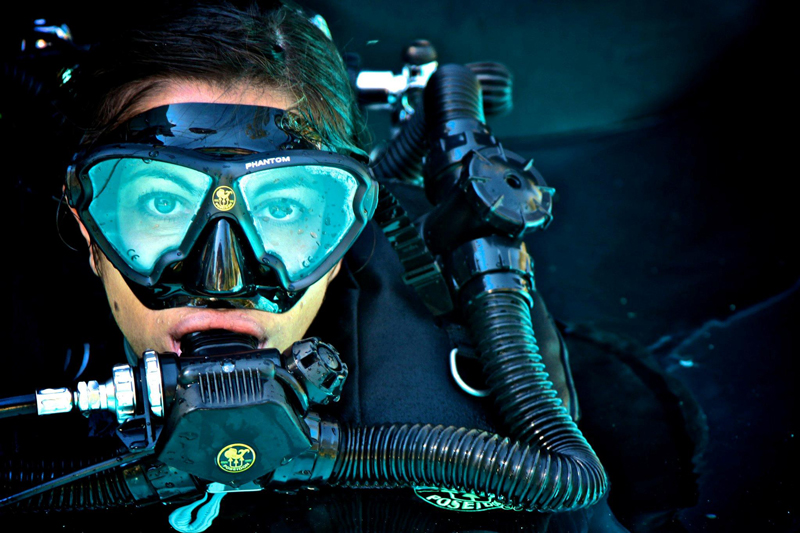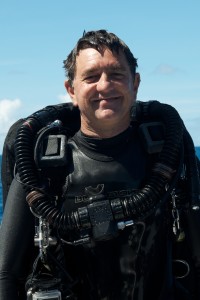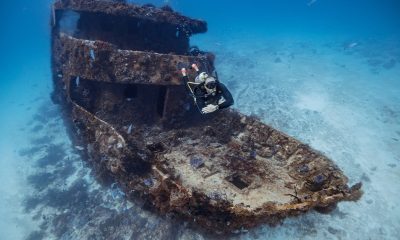News
Rebreather 101 with Paul Toomer

How many of you have heard of Jacques Cousteau? All of you, right?
If you don’t know who he is, you need to be on the ‘Horse and Hounds’ or ‘Amateur Rambling in the Cotswolds’ website rather than Scubaverse. He invented SCUBA didn’t he? Didn’t he also write a book called the silent world?
 Now, we all know he didn’t invent SCUBA; that was actually some geezer whose name we can’t remember and Mr C just stole all the glory, right?
Now, we all know he didn’t invent SCUBA; that was actually some geezer whose name we can’t remember and Mr C just stole all the glory, right?
Wrong! Well… partially wrong. Mr C stole the open circuit glory but not SCUBA. SCUBA is self contained underwater breathing apparatus and it was invented a long, long time ago. And it was a Closed Circuit Rebreather (CCR). That is why his world was SILENT. Open circuit is hardly bloody silent. If you don’t believe me, take a try dive on a rebreather and listen for when the hordes of wildebeest come charging past you blowing those confounded bubbles.
What is a Rebreather?
A rebreather is a closed breathing circuit (loop) enabling gas to be recycled, therefore giving the user an extended use of the limited gas that he/she carries. There are two primary problems that have to be overcome to make the rebreather work though. The first is the fact that we metabolise oxygen, and if we breathe too low an amount of oxygen it can cause unconsciousness, which could of course lead to an ultimately death. A by-product of oxygen metabolism is the creation of carbon dioxide, and this insidious gas can also lead to unfortunate circumstances, especially underwater (as I’m sure you can imagine).
The loop and how it works
When a diver exhales, his breath is forced through a non-return valve which forces the exhaled air through a carbon dioxide removal system known as a scrubber (I love that word). The scrubber is made up of a chemical called Sofnalime, which is primarily calcium hydroxide. The exhaled breath is scrubbed clean of carbon dioxide and the breath is now pushed through an area where oxygen analysers analyse how much oxygen is left in that cleaned breath. The analysers talk to a computer (the unit holds a constant PO2 or oxygen partial pressure) which then tells a solenoid to open and add oxygen to the loop if required. This can also be done manually of course in the event of any problems.
 There are also counterlungs on the unit, which allow the diver to breathe gas around the loop. Without the counterlung the diver would be unable to breathe. It’s similar to trying to breath out of a glass bottle; it’s impossible. However, breathing out of a plastic bag is possible, although very unsafe. As the diver descends in the water hydrostatic pressure acts on the counterlung and compresses the gas within it. To enable the diver to breathe, diluent gas (a gas containing one or more inert gasses, normally air or trimix) is manually or automatically added to the loop.
There are also counterlungs on the unit, which allow the diver to breathe gas around the loop. Without the counterlung the diver would be unable to breathe. It’s similar to trying to breath out of a glass bottle; it’s impossible. However, breathing out of a plastic bag is possible, although very unsafe. As the diver descends in the water hydrostatic pressure acts on the counterlung and compresses the gas within it. To enable the diver to breathe, diluent gas (a gas containing one or more inert gasses, normally air or trimix) is manually or automatically added to the loop.
Finally, due to the fact that the CCR holds a constant PO2, compared to open circuit where it’s optimum PO2 is only achieved at the Maximum Operating Depth, rebreathers will penalise the diver less in terms of decompression obligation. Another huge plus.
Gas, Gas, Gas!
 Rebreathers work on metabolic rate and not surface air consumption rate. This means that if a diver uses 20 litres of air a minute but only metabolises 1 litre of oxygen, the rebreather is massively more effective at conserving gas. An example of this based on the above gas usage rates would be: An open circuit diver is at 30 metres on the Thistlegorm, for example, and is there for 30 minutes. He uses 20 litres/min x4 ata (30 metres) x30 minutes = 2400 litres of gas, or a full 12 litre cylinder pumped to 200 bar. If a CCR diver was at the same depth and for the same time he would use only 30 litres of oxygen. Therefore, if the CCR diver had a 2 litre cylinder filled to 200 bar, he would have 400 litres available. Based on a 1 litre metabolic rate that diver could stay on the Thistlegorm for 400 minutes or 6.66 hours.
Rebreathers work on metabolic rate and not surface air consumption rate. This means that if a diver uses 20 litres of air a minute but only metabolises 1 litre of oxygen, the rebreather is massively more effective at conserving gas. An example of this based on the above gas usage rates would be: An open circuit diver is at 30 metres on the Thistlegorm, for example, and is there for 30 minutes. He uses 20 litres/min x4 ata (30 metres) x30 minutes = 2400 litres of gas, or a full 12 litre cylinder pumped to 200 bar. If a CCR diver was at the same depth and for the same time he would use only 30 litres of oxygen. Therefore, if the CCR diver had a 2 litre cylinder filled to 200 bar, he would have 400 litres available. Based on a 1 litre metabolic rate that diver could stay on the Thistlegorm for 400 minutes or 6.66 hours.
6.66 hours compared to 30 minutes? A gigantic difference I am sure you’ll agree. This is the primary reason that deep technical divers prefer CCR. It’s all in the gas.
Aquatic Life
I took a CCR to the Maldives on a liveaboard a few years ago. I never went past 40 metres for the two weeks I was there and apart from the fact that I never had any decompression schedule, I was swamped by the aquatic life. I was chased by barracuda, nibbled by moray eels, had a 2 metre stingray push me down the reef as if I was not there. Mantas thought I was some kind of weird yellow box fish and finally, the sharks…..oh my God, it was unbelievable! I had white tips on a night dive try and beat me up, chewing my fins and rubbing themselves on me as they went passed, banging into me to see what I was….just incredible. It was one of the best dives of my entire life. This dive alone was enough reason to spend all that money on my unit.
Here is a little history for you:
- 17th century – the first rebreather was conceived by Giovanni Borelli
- 1878 – the first practical system produced by Henry Fleuss, who after diving his fully working unit swore he would never dive in the damnable thing ever again. He absolutely shit himself while doing some work in a flooded tunnel.
- 1881 – the first CO2 absorbent used by Khotinsky and Lake
- Prior to WWI – Dräger started produced rebreather systems. Mainly used for blowing the crap out of poor old Allies.
- WWII – Italian & British Navies used Oxygen & Nitrox systems. The Italian units were mainly used for long swims away from enemy lines back to Italy. The British units were primarily used for blowing the crap out of the Axis countries.
- 1990s – manufacturers launch many units including: Sentinel, Inspiration, Evolution, Megaladon, Ouroboros, Kiss, Optima, rEvo, Poseidon Mk 6, etc.
 All that is left to do now is pick your unit, get some top end training and go and play. I assure you this is the future.
All that is left to do now is pick your unit, get some top end training and go and play. I assure you this is the future.
Next time we will look at some of the CCRs available, their features, recreational and technical CCR, and of course training options.
Please note that this article covers the basics of CCR. I really hope it gives you a little understanding of rebreathers, as I believe they are the way we will all dive in the future.
 Paul is the Director of Training at RAID. To find out more about the courses that RAID offers, visit www.diveraid.com.
Paul is the Director of Training at RAID. To find out more about the courses that RAID offers, visit www.diveraid.com.
Gear News
Introducing the TR-80, IR-50 and CS-30 Regulators from DYNAMICNORD

Whether you are a beginner or a professional diver – with the three new main regulators from DYNAMICNORD, everyone will find their favourite regulator. They all look super stylish.
Excellent performance with the TR-80
Quality and performance are the be-all and end-all for regulators. It is not for nothing that the TR stands for Tec Reg. The innovative design of the TR-80 guarantees absolute reliability – even in ice-cold waters.

Perfect breathing effort at 0.8 J/l / certified for diving in waters below 10 degrees / structural design made of solid brass for best cold protection / membrane-compensated design with dry seal of the first stage / reduced exhalation effort thanks to optimized exhalation membrane and bubble deflector / adjustable Venturi (dive/predive) and adjustment knob for individual inhalation comfort / innovative design of the front cover prevents free-flow in strong currents or when diving with scooters / design made of sandblasted brass, matt chrome finish / 2 HP and 4 LP outlets / mouthpiece made of high-quality, anti-allergic silicone for maximum comfort.


Amazing underwater adventures with the IR-50
The IR-50 is the top regulator for advanced and experienced divers. Natural breathing is the essence of this regulator.

Ideal breathing effort at 0.8 J/l /certified for diving in waters below 10 degrees / compensated membrane / adjustable venturi (dive/predive) and adjustment knob for individual inhalation comfort/ outlet valve and deflector for minimum exhalation effort and reduction of bubbles on the face / design made of sandblasted brass, matt chrome finish / 2 HP and 4 NP outlets / mouthpiece made of high-quality, anti-allergic silicone for maximum comfort.


The Workhorse – our CS-30
For diving centres and diving beginners – the workhorse stands for strong construction, reliability and robustness. Perfect for your training.

Optimal breathing effort at 0.8 J/l /recommended for diving in waters above 10 degrees / non-compensated piston / adjustable venturi (dive/predive) / outlet valve and deflector for minimum exhalation effort and reduction of bubbles on the face / design made of sandblasted brass, matt chrome finish / 1 HP and 3 NP outlets / mouthpiece made of high-quality, anti-allergic silicone for maximum comfort.


Octopus OP-30
The OP-30 is the ideal addition to all DYNAMICNORD regulators. It is identical in construction to the CS-30.

The TR-80, IR-50, CS-30 (DIN & INT) regulators and the Octopus OP-30 are available from DYNAMICNORD dealers and in the online store.
DYNAMICNORD – Your Outdoor Companion.
Marine Life & Conservation
Paul Watson Released as Denmark Blocks Japan’s Extradition Bid

Renowned anti-whaling activist Paul Watson has been released from custody in Greenland after spending five months in detention. Denmark’s Justice Ministry rejected Japan’s request for his extradition, citing insufficient guarantees that his time already served in custody would be credited against any potential sentence.
The 74-year-old Canadian-American was arrested on July 21 in Nuuk, Greenland’s capital, when his ship docked to refuel. His arrest was based on a 2012 Japanese warrant related to a 2010 encounter in Antarctic waters. Japan alleged Watson obstructed operations and caused damage to a whaling research ship during efforts to disrupt illegal whaling. Watson has consistently denied these claims, maintaining his commitment to marine conservation.
Denmark, which oversees extradition matters for Greenland, concluded that while the legal conditions for extradition were met, the lack of assurances from Japan regarding time-served credit made extradition untenable.
In a video shared by his foundation, Watson expressed gratitude and relief, saying, “After five months, it’s good to be out… and good to know they’re not sending me to Japan.” He added that the most difficult part of his time in custody was being separated from his two young sons.
Watson is a pioneering figure in marine conservation, known for founding the Captain Paul Watson Foundation in 2022 after decades of activism with the Sea Shepherd Conservation Society. His bold efforts to defend marine life have earned him widespread support, including from celebrities and conservationists. His work has also been featured in the acclaimed reality TV series Whale Wars.
Watson’s lawyer, Jonas Christoffersen, praised the decision, stating, “We are happy and relieved that Paul Watson is now free.” He added that Watson is eager to reunite with his family and continue his vital work.
The arrest occurred while Watson’s vessel, the M/Y John Paul DeJoria, was en route to the North Pacific with a team of 26 volunteers to intercept a Japanese whaling ship. His foundation described the arrest as politically motivated and emphasized that Watson’s actions were focused on ending illegal whaling practices.
Japan resumed commercial whaling in 2019 after leaving the International Whaling Commission, asserting that whale meat is a cultural tradition. Conservationists, however, continue to challenge these practices, highlighting their impact on marine ecosystems.
Despite the challenges, Watson remains steadfast in his mission to protect marine life and bring attention to whaling practices. His dedication to ocean conservation has made him a globally respected advocate for the environment.
-

 News2 months ago
News2 months agoIconic SS United States to become the World’s Largest Artificial Reef
-

 News3 months ago
News3 months agoBook Review – 52 Assignments: Underwater Photography
-

 Gear News3 months ago
Gear News3 months agoDYNAMICNORD – New German diving brand enters the British market
-

 News3 months ago
News3 months agoExploring Cenote El Pit: A Diver’s Dream
-

 Gear News3 months ago
Gear News3 months agoTry BARE drysuits (and maybe even win one!) this Friday with Sea & Sea at North West Dive Fest
-

 Marine Life & Conservation3 months ago
Marine Life & Conservation3 months agoBook Review: Coral Triangle Cameos
-

 Blogs2 months ago
Blogs2 months agoDive the Egyptian Red Sea this Autumn with Regaldive
-

 News3 months ago
News3 months ago2024 Ocean Art Underwater Photo Competition Announced















